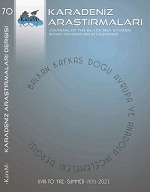ESKİ UYGURCA ORGAN ADLARIYLA OLUŞTURULMUŞ KALIPLAŞMIŞ DİL BİRİMLERİ
FORMULAIC EXPRESSIONS CREATED THROUGH ORGAN NAMES IN OLD UYGHUR
Author(s): Murat Elmali, Botan C. EkmenSubject(s): Language studies, Theoretical Linguistics, Historical Linguistics, Turkic languages
Published by: Karadeniz Araştırmaları Merkezi
Keywords: Old Turkish; Old Uyghur; Organ Names; Formulaic Language;
Summary/Abstract: Formulaic expressions hold a special place in language. They are one the most important elements of language – culturally, socially, semantically, syntactically, and morphologically. Linguists therefore ought to examine them as they concern various domains of language and linguistics – both modern and historical alike. This study examines how Old Uyghur [would have] used formulaic language units (compounds, reduplications, idioms, proverbs, formulaic expressions (phrases)). Old Uyghur is extremely rich in this sense. We confined this study only to terms for [human] organs and compounds, reduplications, idioms, proverbs, and formulaic expressions (phrases) thereof. We tried to prove that Old Uyghur – and thus the Old Turkish – were good at making formulaic expressions out of organs. Even in early Turkish, the presence of such phases as kizlek oron (private parts, genitalia), kaşanıg yolı (urinary tract), et kırtış (flesh, skin), and agızıntın ün- (pass someone’s lips, to say) demonstrate just how deep Turkic languages are when it comes to meaning.
Journal: Karadeniz Araştırmaları
- Issue Year: 2021
- Issue No: 70
- Page Range: 429-448
- Page Count: 20
- Language: Turkish

